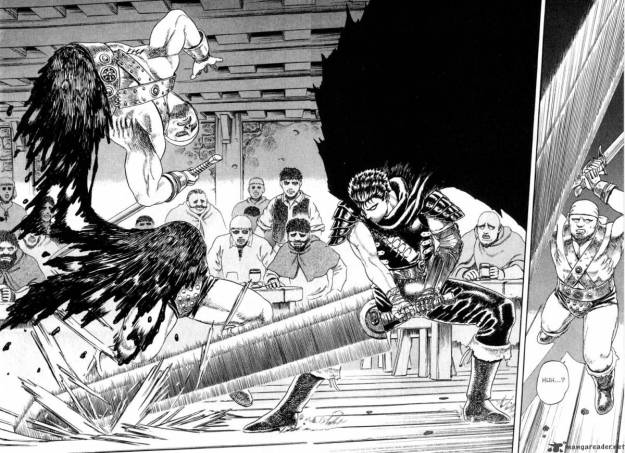The second volume of Berserk, the ongoing manga series by writer and illustrator Kentaro Miura builds upon the dark and gory atmosphere of the first volume (written about by me here) and moves along the plot-lines begun in the aforementioned previous volume. The two chapters present in this volume were originally collected in 1991 in Japanese, while the English translation is published by Dark Horse Manga.
The volume opens where the last left off, with Guts and Puck being led to a hideout by a terribly scarred man who was sworn to take his revenge on the demonic count in charge of the city. Guts sees this setback turn into an opportunity upon seeing a behelit, a living key that allows him access to the God Hand, or those whom he seeks to destroy. The behelit was formerly the property of the Count until it was stolen by the broken man before them as he had escaped from his tormentors. Guts kills many more people and eventually comes face to face with the regenerative count, while Puck ends up in the possession of Theresia, the Count’s daughter, who has been caged within the finery of her bedroom by her father. The two chapters in this volume are titled “The Guardians of Desire, Part 2” and “The Guardians of Desire, Part 3.”
The character of Guts is not fleshed out much more in this volume aside from the implication that he has survived what it is impossible for a mortal to survive and that he may know more about the demonic element in the story than anyone that is not actually demonic. Guts continues to be terse and, arguably, cruel towards Puck, but there appears to be something of a bond developing between the two, even if it is only the nature of this type of story that is telling me so. Guts once again demonstrates his prodigious ability with the sword, to the point where he matches a super-powered demon blow for blow and defeats him. We learn a little bit more about what makes Guts tick, particularly in regards to people who do not fight their own battles, but his past thus far remains a cipher Guts continues to be interesting as a character, but hopefully details about him aside from how awesome he is with a sword will be revealed soon.
Puck the elf continues to be simultaneously intrigued and disappointed by Guts, yet slowly begins to understand his attitude more after viewing the hellish and violent world he lives in day in and day out. Puck also becomes a more proactive character rather than just insisting that Guts be proactive for him: in this volume when he takes it upon himself to try to save someone from the Count, even if that doesn’t turn out so well for either of them. The change in Puck’s demeanor is predictable, but welcome character development, considering he could (still) easily end up being the character to act as Guts’ conscience without actually taking any action through volition of his own.
The art done by Kentaro Miura continues to be stellar, though some of the splash pages when Guts is fighting some monster or other tend to be a bit hectic and overcrowded, though they are not confusing story-wise. His Guts is hulking but not to the unrealistic degree certain comic characters can be drawn. His Puck is minuscule, youthful (at least appearance-wise), and very expressive, which is good when the character is a fraction of the size of the other figures he shares panel space with.
The setting is still reminiscent of a European influenced medieval world, with monsters and such added in, but this volume spends more time focusing on the fantasy elements than the initial one. The dark and foreboding atmosphere is consistent from the last volume, with an even greater sense of menace behind the scenes with Guts seemingly getting ever closer to the enigmatic “God Hand” that he seeks for what is seemingly revenge, but could potentially be something else.
This volume picks up where the last one left us, and leaves us on a significantly more frustrating cliffhanger, but the writing and art remain strong and Berserk has continued to be a worthwhile read. The premise is still frustratingly vague (what is this “God Hand”? Just who is Guts?) but the setting and atmosphere are intriguing and the characters continue to develop interestingly and naturally, if a bit slowly. At any rate, read Berserk if you like a solid medieval epic fantasy or just some fun action involving a gigantic sword.


